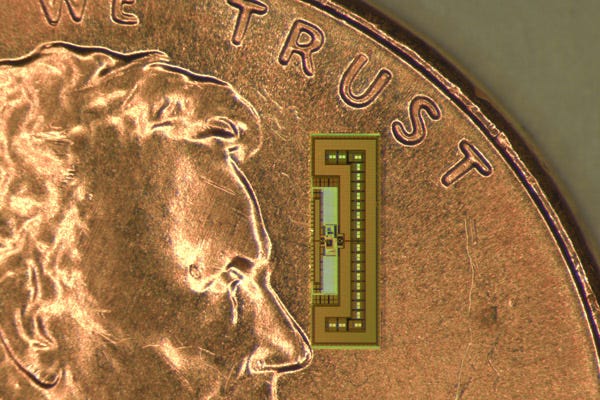September 24, 2014
As technology continues to shrink and automate the world around us, two major challenges are inescapable: finding a sufficient power source, and procuring the aforementioned power source at a reasonable cost.
Recently, Amin Arbabian, an assistant professor of electrical engineering at Stanford University, developed a battery-free chip the size of ant that he maintains will cost only a few cents to make. The device is so energy efficient that it gathers power from the electromagnetic waves that carry signals to its receiving antenna, allowing it to power itself as it operates. Arbabian recently spoke to Stanford news about the development, and how it could shape the future of connecting smaller devices.
|
The chip, roughly the size of an ant, would cost pennies to make. |
"The next exponential growth in connectivity will be connecting objects together, and giving us remote control through the Web," he said. Arbabian recently demonstrated the tiny radio chip at the VLSI Technology and Circuits Symposium in Hawaii.
As medtech devices continue to shrink, and the power to monitor and control many of these devices shifts onto smartphones and tablets, the chip could prove to be revolutionary, if it lives up to the hype. Its size and low cost could pave the way for the production of smaller, more portable devices to be used and controlled from the touch of a smartphone.
Much of the infrastructure for such an environment as been in place for some time. We've had the Internet to help us connect devices, and the introduction of smartphones and tablets gives us the ability to control these devices and issue commands. Unfortunately a powerful, affordable chip to connect these devices to the Internet has proved to be the missing link. That is, until now.
Originally designed to compute, execute, and relay commands, this little microchip can be constructed for a few pennies, making it cheap enough to bring to life the idea of the "Internet of Things," a vision devised by Kevin Ashton in 2000 in which common objects can be interconnected through the internet, allowing advanced connectivity between devices.
The technology certainly isn't the first of its kind, as researchers continue to explore the possibilities of tiny chips that can be self sufficient without the need for external battery power. The low cost has proven to be critical, as we ultimately aim to connect trillions of devices across countless industries. As we look to connect smart household devices into an efficient system of cohesion, these tiny, self-powered radio controllers will prove to be essential in bringing the Internet of Things idea to life.
The other beneficial byproduct of this would be the reduction of power consumption--a single chip would draw considerably less power than conventional power sources. If Arbabian's chip required a battery, which it does not, a single AAA battery could power the chip for more than a century. This, in part, is why the chip is so self sufficient. Its low power needs enable it to gather enough power to operate independently, eliminating the need for other power-hungry devices.
While other obstacles remain, Arbabian and his team continue to work toward a vision that enables devices to connect and operate on a single network seamlessly and efficiently. This chip could be the first major step in that direction, a world where all our devices can be powered efficiently, and controlled by the touch of a button.
Refresh your medical device industry knowledge at MD&M Chicago, October 15-16, 2014, and MD&M Minneapolis, October 29-30, 2014. |
Kristopher Sturgis is a contributor to Qmed and MPMN.
Like what you're reading? Subscribe to our daily e-newsletter.
About the Author(s)
You May Also Like



